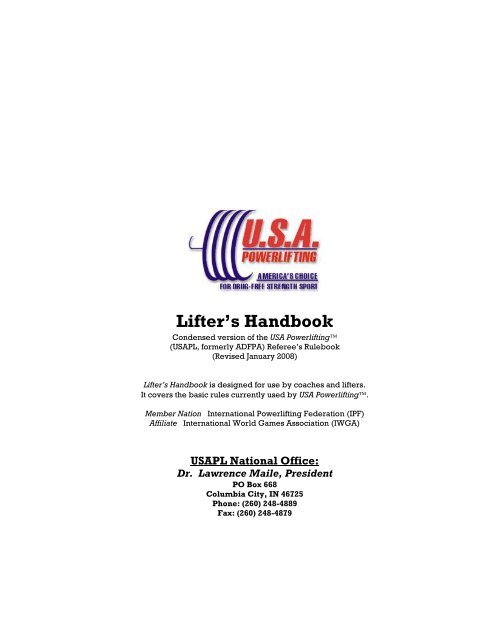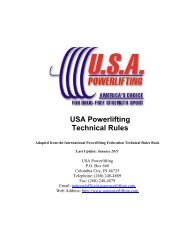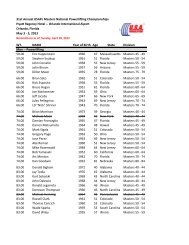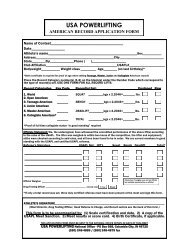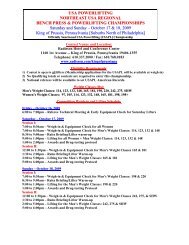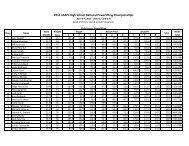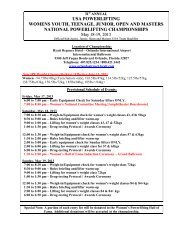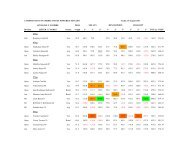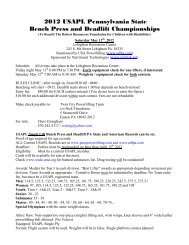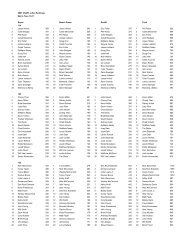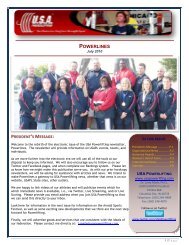Lifter's Handbook - USA Powerlifting
Lifter's Handbook - USA Powerlifting
Lifter's Handbook - USA Powerlifting
Create successful ePaper yourself
Turn your PDF publications into a flip-book with our unique Google optimized e-Paper software.
Lifter’s <strong>Handbook</strong><br />
Condensed version of the <strong>USA</strong> <strong>Powerlifting</strong><br />
(<strong>USA</strong>PL, formerly ADFPA) Referee’s Rulebook<br />
(Revised January 2008)<br />
Lifter’s <strong>Handbook</strong> is designed for use by coaches and lifters.<br />
It covers the basic rules currently used by <strong>USA</strong> <strong>Powerlifting</strong>.<br />
Member Nation International <strong>Powerlifting</strong> Federation (IPF)<br />
Affiliate International World Games Association (IWGA)<br />
<strong>USA</strong>PL National Office:<br />
Dr. Lawrence Maile, President<br />
PO Box 668<br />
Columbia City, IN 46725<br />
Phone: (260) 248-4889<br />
Fax: (260) 248-4879
PERSONAL EQUIPMENT<br />
All items worn on the platform MUST be CLEAN, UNTORN and in a good state of repair or they will NOT pass the equipment check<br />
procedures. Support briefs or support underwear are NOT allowed. Obscenities or profanities are NOT allowed on any attire to be worn<br />
in the competitive area. Leotards are NOT permitted. Hats are NOT permitted on the platform; the lifter may wear professionally-made<br />
headbands.<br />
Costume<br />
Supportive<br />
Only costumes officially registered and approved by the IPF Technical Committee shall be permitted for use in <strong>Powerlifting</strong> and<br />
Bench Press Competitions.<br />
Non Supportive<br />
W/L /Wrestling/Leotard/singlet. Subject to the specifications itemized (c), (d) and (e). The suit does not require Technical<br />
Committee approval.<br />
A lifting costume must be worn and shall be of a one - piece full length lifting suit of one - ply stretch material without any<br />
patches, padding or division into panels by means of seams not necessary in the manufacture of the costume. Any seams, false or<br />
otherwise, that in the opinion of the Technical Committee, Jury, or in their absence the referees are incorporated into the costume<br />
purely as a form of reinforcement or bracing, shall invalidate the costume from being used in the competition.<br />
The costume must be form fitting without any looseness when worn by the lifter. The straps must be worn over the shoulders at all<br />
times while lifting in competition. The lifting suit shall be subject to the following requirements:<br />
(a) It may be of any color or colors<br />
(b) The lifting suit may bear the badge, emblem, logo and/or inscription of the lifter’s national or local level association, his/her<br />
<strong>USA</strong>PL registered club or sponsor, or his/her <strong>USA</strong>PL Regional/State logo. That which is offensive or liable to bring the<br />
sport into disrepute is not allowed.. The lifter’s name may be placed on the costume, or on any item of personal apparel.<br />
(c) Seams and hems must not exceed 3 cm in width and 0.5 cm in thickness. Only non-supportive leotard / singlet suits may<br />
have seams and hems exceeding 3 cm in width. The non-supportive leotard / singlet may also have a double thickness of the<br />
same material size 12 cm x 24 cm in the area of the crotch.<br />
(d) Seams may be protected or strengthened by narrow gauge webbing or stretch material not exceeding 2 cm in width and 0.5<br />
cm in thickness.<br />
(e) It must have legs. The length of leg must be a minimum of 3 cm and maximum of 15 cm. Measurement is to be taken on a<br />
line from the top of the crotch down the inside of the leg. The leg of the suit needs not to be cut to form exactly a parallel<br />
around the leg. It may be cut higher on the outside of the leg. Non supportive costumes may have leg length to a maximum<br />
of 25 cm.<br />
(f) Any alterations to the costume which exceed the established widths, lengths or thicknesses previously stated shall make the<br />
suit illegal for competition.<br />
(g) Although alterations/pleats to form a tightening of the suits and supportive shirts do not make them illegal, these must be<br />
made on the original seams.<br />
(h) Should a tightening have been made, the excess material must not be folded and sewn back on to the suit. It is recommended<br />
that when the costume shoulder straps are shortened they are sewn in such a way that the excess material is under the strap,<br />
rather than the unsightly tufts that appear when material is above the straps.<br />
(i) In High School-Only meets, form fitting shorts and T-shirts may be worn, as approved by the officials.<br />
T Shirt / Supportive Shirt<br />
A T-Shirt or support shirt (the support shirt shall be of one ply stretch material) of any color or colors must be worn under the<br />
lifting suit during the performance of the squat and bench press, but is optional for the men in the deadlift. A combination of the<br />
two is forbidden. Women must wear a T-Shirt or support shirt while competing on all lifts.<br />
Support shirts as approved by the Technical Committee and noted in the list of approved equipment and clothing issued<br />
periodically by the committee may be worn for all lifts. All of the conditions as defined for the T-Shirt also apply to the support<br />
shirt. The support shirt cannot be so long as to cover the buttocks when tucked into the suit and therefore serve as extra support.<br />
In addition seams may only be placed in the positions indicated in the diagram.<br />
The T Shirt is subject to the following conditions:<br />
(a) Does not consist of any rubberized or similar stretch material.<br />
(b) Does not have any pockets, buttons, zippers, collar, or V - neck.<br />
(c) Does not have reinforced seams.<br />
(d) Is made of cotton or polyester or a mixture of cotton and polyester. Denim is not acceptable.<br />
(e) It shall not have sleeves which terminate either below the elbow or at the deltoid. Lifters may not push or roll the sleeves of<br />
the T-Shirt up to the deltoid when competing in <strong>USA</strong>PL competition. T-Shirts must not be worn inside out. The “Support<br />
Shirt” as used in the squat and deadlift may be “sleeveless”.<br />
(f) Is plain, the official T-Shirt of the contest or bears the badge and or inscription of the lifter’s nation, national or regional<br />
federation or sponsor. Powerlifitng federation refernces are limited to <strong>USA</strong>PL, NAPF or IPF. That which is offensive or<br />
likely to bring the sport into disrepute is not allowed.
Briefs<br />
(a)<br />
(b)<br />
(c)<br />
(d)<br />
Socks<br />
(a)<br />
(b)<br />
(c)<br />
(d)<br />
(e)<br />
Belt<br />
A standard commercial “athletic supporter” or standard commercial briefs (not boxer shorts) of any mixture of cotton, nylon<br />
or polyester shall be worn under the lifting suit.<br />
Women may also wear a commercial or sports bra.<br />
Swimming trunks or any garment consisting of rubberized or similar stretch material except in the waistband, shall not be<br />
worn under the lifting costume.<br />
Any supportive undergarment, including those with underwire support, is not legal for use in <strong>USA</strong>PL competition.<br />
They may be of any color or colors and may have manufacturer’s logos.<br />
They shall not be of such length on the leg that they come into contact with the knee wraps or knee cap supporter.<br />
Full length leg stockings, tights or hose are strictly forbidden.<br />
Socks may be worn in the squat and bench press. Shin length socks must be worn to cover and protect the shins while<br />
performing the deadlift.<br />
Light protective guards between sock and shin may be worn.<br />
Competitors may wear a belt. If worn, it shall be on the outside of the lifting suit.<br />
Materials and Construction:<br />
(a) The main body shall be made of leather, vinyl or other similar non-stretch material in one or more laminations which may be<br />
glued and/or stitched together.<br />
(b) It shall not have additional padding, bracing or supports of any material either on the surface or concealed within the<br />
laminations of the belt.<br />
(c) The buckle shall be attached at one end of the belt by means of studs and/or stitching.<br />
(d) The belt may have a buckle with one or two prongs or “quick release” type (“quick release” referring to lever.)<br />
(e) A tongue loop shall be attached close to the buckle by means of studs and/or stitching.<br />
(f) The name of the lifter, the lifter’s nation, state or club may appear on the outside of the belt.<br />
Dimensions:<br />
1. Width of belt maximum 10 cm.<br />
2. Thickness of belt maximum 13 mm along the main length.<br />
3. Inside width of buckle maximum 11 cm.<br />
4. Outside width of buckle maximum 13 cm.<br />
5. Tongue loop maximum width 5 cm.<br />
6. Distance between end of belt and far end of tongue loop maximum 25 cm.<br />
Correct Points of Measurement:<br />
Shoes or boots<br />
Shoes or boots shall be worn.<br />
(a) Shoes shall be taken to include only Sports Shoes/Sports Boots; W/L, P/L Boots or Deadlift Slippers. The above is referring<br />
to indoor sports e.g. wrestling/basketball. Hiking boots and cleated shoes do not fall into this category<br />
(b) No part of the underside shall be higher than 5 cm.<br />
(c) The underside must be uniform on both sides.<br />
(d) Loose inner soles that are not part of the manufactured shoe shall be limited to one centimeter thickness.
Wraps<br />
Only wraps of one-ply commercially woven elastic that is covered with polyester, cotton or a combination of both materials or<br />
medical crepe are permitted.<br />
Wrists<br />
1. Wrists wraps shall not exceed 1 m. in length and 8 cm. in width. Any sleeves, and Velcro patches or tabs for securing<br />
must be incorporated within the one meter length. A loop may be attached as an aid to securing. The loop shall not be<br />
over the thumb or fingers during the actual lift.<br />
2. Standard commercial sweat bands may be worn, not exceeding 12 cm in width. A combination of wrist wraps and<br />
sweat bands is not allowed.<br />
3. A wrist covering shall not extend beyond 10 cm above and 2 cm below the center of the wrist joint and shall not exceed<br />
a covering width of 12 cm.<br />
Knees<br />
1. Wraps not exceeding 2 m in length and 8 cm in width may be used. A knee wrap shall not extend beyond 15 cm above<br />
and 15 cm below the centre of the knee joint and shall not exceed a total covering width of 30 cm. An elasticised knee<br />
cap supporter not exceeding 30 cm in length may be worn. Knee sleeves 30 cm in length are also legal and the<br />
medical/surgical sleeves are also an option. A combination of the two is strictly forbidden. Neoprene may be<br />
“synthetic” rubber but is only acceptable in the knee sleeve.<br />
2. Wraps shall not be in contact with the socks or lifting suit.<br />
3. Wraps shall not be used elsewhere on the body.<br />
Supportive wraps:<br />
Only wraps from commercial manufacturers officially registered and approved by the Technical Committee shall be<br />
permitted for use in powerlifting competitions.<br />
Non supportive wraps:<br />
Wraps made of medical crepe or bandage and sweatbands do not require Technical Committee approval.<br />
(a)<br />
(b)<br />
(c)<br />
Two layers of medical tape may be worn on the thumbs. Medical tape or its like may not be worn anywhere else on the body<br />
without official permission of the Jury, or Chief Referee. Medical tape may not be used as aids to the lifter in holding the<br />
bar.<br />
Contingent upon prior approval by the Jury, Official Doctor, Paramedic or Paramedical personnel on duty medical tape may<br />
be applied to bodily injuries in a fashion that would not grant the lifter an undue advantage.<br />
At all competitions where a jury may not be present and no medical personnel are on duty the Chief Referee shall have<br />
jurisdiction over the use of medical tape.<br />
General<br />
(a) The use of oil, grease or other lubricants on the body, or personal equipment is strictly forbidden.<br />
(b) Baby powder, resin, talc or magnesium carbonates are the only substances that may be added to the body and attire. Not the<br />
wraps.<br />
(c) The use of any form of adhesive on the underside of footwear is strictly forbidden. This applies to any built in adhesive, e.g.<br />
glass paper, emery cloth, etc. And to include resin and magnesium carbonate. A spray of water is acceptable.<br />
(d) No foreign substances may be applied to the powerlifting equipment. This takes into account all substances other than that<br />
which may be used periodically as a sterile agent in the cleaning of the bar, bench, or platform.<br />
Rule Regarding Equipment Infractions or Rejections<br />
(a)<br />
(b)<br />
(c)<br />
(d)<br />
Equipment which is rejected may be resubmitted within the specified inspection time after it has been altered to meet<br />
regulations.<br />
The costume, with the exception of the belt, may NOT be adjusted on the lifting platform. The belt may be adjusted.<br />
The lifter may be warned of minor attire infractions which could be cleared up before reaching the platform.<br />
If after inspection, a lifter appears on the platform wearing or using any illegal items not marked at equipment check, the<br />
lifter will be immediately disqualified from the competition.<br />
<strong>USA</strong>PL BANNED SUBSTANCE RULE<br />
The <strong>USA</strong>PL has a 3-year drug-free period prior to the competition of individual members. All <strong>USA</strong>PL members are subject to out-ofmeet<br />
testing without prior notice. If a lifter tests positive, there is a retest procedure found in the Referee’s Rulebook. The sanction<br />
placed against the lifter who tests positive in the drug testing procedure is: 2 year suspension for anabolic steroids, diuretics and related<br />
compounds. A second offense draws a lifetime suspension. The suspension from lifting begins on the date the test is administered.<br />
<strong>USA</strong>PL doping policies are modeled after WADA guidelines, which will be applied also in cases for substances not covered above.<br />
Banned substances include, but are not limited to Anabolic Steroids and Growth Hormones. SPECIAL NOTE: Prescription<br />
Diuretics and Psychomotor Stimulants are not allowed and cannot be used for a 7 day period prior to the competition. A Therapeutic<br />
Use Exemption (TUE) should be applied for any and all prescription medications taken by an athlete. Over-the-Counter (OTC)<br />
medicines and supplements may violate doping regulations and result in a positive doping control test.
RULES OF PERFORMANCE<br />
Attempts<br />
(a) Starting attempts for all three lifts must be declared by the lifter at the weigh-in. One change on the first attempt may occur<br />
up to 5 minutes prior to the starting time for each flight.<br />
(b) No changes are permitted in the second and third attempts with the exception of the third attempt deadlift, which may be<br />
changed twice. During bench press only competitions the third attempt may be changed twice, under the same conditions as<br />
the deadlift during 3 lift competitions.<br />
(c) The lifter or coach has 1 minute between completing the last attempt and submitting to officials the weight for their next<br />
attempt. If the lift is not turned in within 1 minute, the next attempt will be raised 2.5kg or 5 lb.<br />
(d) Increases between each attempt must be a minimum of 2.5 kg or 5 lb. The exception is that if a lifter misses an attempt, that<br />
same weight may be repeated.<br />
(e) Three unsuccessful attempts in any lift will result in no total and eliminate the lifter from scoring, placing or best lifter<br />
awards. The lifter may, however, continue in the meet at the discretion of the Technical Secretary.<br />
(f) Once the bar has been called loaded by the Chief Referee, the lifter has 1 minute to get the signal to start or the attempt will<br />
be forfeited.<br />
Order of Lifting<br />
(a) <strong>USA</strong>PL 3 lift competitions must use the rounds system.<br />
(b) In the rounds system, the bar is loaded progressively for each attempt. The lifter requiring the lightest weight lifts first.<br />
(c) When two or more lifters declare the same attempt, they lift in the order determined by Lot Numbers which were drawn<br />
during weigh-in or equipment check. If Lot Numbers were not used, the lighter lifter goes first.<br />
(d) In the rounds system, all lifters in the first flight will complete their first attempt, then their 2 nd attempt and then their 3 rd<br />
attempt of the squat prior to the start of the squat event for the next flight. As all flights in the session complete the squat<br />
event, the first flight will return to begin the bench press, etc.<br />
(e) The squat is always done first, followed by the bench press and then by the deadlift.<br />
Time Limits<br />
(a) When the announcement has been made that the bar is loaded/ready by the Chief Referee, the lifter has 1 minute to get the<br />
signal for that lift.<br />
For the SQUAT, the referee’s signal is “Squat”<br />
For the BENCH PRESS, the referee’s signal is “Start”<br />
For the DEADLIFT, the lifter must make a determined effort to lift the bar from the platform. There is no referee’s<br />
signal to begin.<br />
(b) If the lift does not begin within the time limit, the Chief Referee will give the audible command “Rack” or “Down”<br />
depending on the lift. The lift will be declared “No Lift” and the attempt is forfeited.<br />
(c) If the lifter is in an apparent starting position, two or more referees may keep their hands raised, delaying the start, if they are<br />
not satisfied with the lifter’s starting position. After 5 seconds, if the lifter is not making an attempt to adjust the starting<br />
position, the Chief Referee will give the signal to “Replace” the bar. The lifter must replace the bar, but it is important to<br />
realize that the clock to receive the start signal is still running. The lifter must still receive the start command within the 1<br />
minute time frame.<br />
(d) The lifter must leave the platform within 30 seconds following their attempt. Failure to do so may result in disqualification<br />
of the attempt.<br />
Loading Spotting and Announcing Errors<br />
When errors are made which are not due to the fault of the lifter, that lifter may be given a repeat attempt at their called weight.<br />
This repeated attempt will be taken at the end of the round. If the error occurs with the last lifter of the flight, the lifter will be<br />
given a 3 minute rest before the repeated attempt, 2nd from the last in the flight will be given a 2 minute rest, 3 rd from the last in<br />
the flight will be given a 1 minute rest. This rest time is compensatory time and is not part of the usual 1 minute that the lifter has<br />
to begin their attempt once the bar is announced ready/loaded by the Chief Referee.<br />
Miscellaneous Rules of Performance<br />
a) Coaches may not be on the platform, at the sides or back of the platform during the lift. Coaches must remain outside the<br />
designated lifting area but within the coaches’ area, if one is so designated.<br />
b) Any lifter or coach, who by reason of misconduct upon or near the platform, which is deemed to discredit the sport, shall be<br />
officially warned. If the misconduct continues, the Jury (or referees in absence of a Jury), may disqualify the lifter or order<br />
the coach to leave the area or venue.<br />
c) All lifters must weigh-in within the 1 ½ hour period beginning 2 hours prior to the start of their session
Squat<br />
1. The lifter shall face the front of the platform. The bar shall be held horizontally across the shoulders, hands and fingers<br />
gripping the bar, and the top of the bar not more than the thickness of the bar below the outer edge of the shoulders. The<br />
diagram, on page 7, indicates the legal position of the bar across the shoulders. The hands may be positioned anywhere on<br />
the bar inside and/ or in contact with the inner collars.<br />
2. After removing the bar from the racks, (the lifter may be aided in removal of the bar from the racks by the spotter/loaders) the<br />
lifter must move backwards to establish the starting position. When the lifter is motionless, erect with knees locked, and the<br />
bar properly positioned, the Chief Referee will give the signal to begin the lift. The signal shall consist of a downward<br />
movement of the arm and the audible command “Squat”. Before receiving the signal to “Squat” the lifter may make any<br />
position adjustments within the rules, without penalty. For reasons of safety the lifter will be requested to “Replace” the bar,<br />
together with a backward movement of the arm, if after a period of five seconds he is not in the correct position to begin the<br />
lift. The Chief Referee will then convey the reason why the signal was not given.<br />
3. Upon receiving the Chief Referee’s signal the lifter must bend the knees and lower the body until the top surface of the legs<br />
at the hip joint is lower than the top of the knees. Only one decent attempt is allowed. The attempt is deemed to have<br />
commenced when the lifters knees have unlocked. The bar may move from its starting position downwards on the lifters<br />
back the thickness/diameter of the bar during the performance of the lift.<br />
4. The lifter must recover at will to an upright position with the knees locked. Double bouncing at the bottom of the squat<br />
attempt or any downward movement is not permitted. When the lifter is motionless (in the apparent final position) the Chief<br />
Referee will give the signal to rack the bar.<br />
5. The signal to rack the bar will consist of a backward motion of the arm and the audible command “Rack”. The lifter must<br />
then move forward and return the bar to the racks. For reasons of safety the lifter may request the aid of the spotter/loaders in<br />
returning the bar to, and replacing it in the racks. The lifter must stay with the bar during this process.<br />
6. Not more than five and not less than two spotter/loaders shall be on the platform at anytime. The Referees may decide to the<br />
number of spotter/loaders required on the platform at any time 2, 3, 4, or 5.<br />
Causes for Disqualification of a Squat<br />
1. Failure to observe the Chief Referee’s signals at the commencement or completion of a lift.<br />
2. Double bouncing at the bottom of the lift, or any downward movement during the ascent.<br />
3. Failure to assume an upright position with the knees locked at the commsencement or completion of the lift.<br />
4. Stepping backward or forward although lateral movement of the sole and rocking the feet between the ball and heel is<br />
permitted.<br />
5. Failure to bend the knees and lower the body until the top surface of the legs at the hip joint is lower than the top of the<br />
knees, as in the diagram.<br />
6. Any movement of the bar on the back more than the diameter/thickness of the bar below its starting position.<br />
7. Contact with the bar or the lifter by the spotter/loaders between the Chief Referee’s signals in order to make the lift<br />
easier.<br />
8. Contact of the elbows or upper arms with the legs. Slight contact is permitted if there is no supporting that might aid<br />
the lifter.<br />
9. Any dropping or dumping of the bar after completion of the lift.<br />
10. Failure to comply with any of the items outlined under Rules of Performance for the squat.<br />
The diagrams below indicate the legal bar position and required depth in the squat:
Bench Press<br />
1. The bench shall be placed on the platform with the head facing the front or angled up to 45 degrees.<br />
2. The lifter must lie on his back with head, shoulders and buttocks in contact with the bench surface. The feet must be flat on<br />
the floor (as flat as the shape of the shoe will allow). His hands and fingers must grip the bar positioned in the rack stands<br />
with a thumbs around grip. This position shall be maintained throughout the lift.<br />
3. To achieve firm footing the lifter may use flat surfaced plates or blocks not exceeding 30 cm in total height to build up the<br />
surface of the platform. Blocks in the range of 5 cm, 10 cm, 20 cm, 30 cm, should be made available for foot placement at all<br />
international competitions.<br />
4. Not more than five and not less than two spotter/loaders shall be on the platform at anytime. After correctly positioning<br />
himself, the lifter may enlist the help of the spotter/loaders in removing the bar from the racks. The lift-off if, assisted by the<br />
spotter/loaders, must be at arms length.<br />
5. The spacing of the hands shall not exceed 81 cm measured between the forefingers (both forefingers must be within the 81<br />
cm marks and the whole of the forefingers must be in contact with the 81 cm marks if maximum grip is used). If in the case<br />
of some old injury or anatomically the lifter is unable to grip the bar equally with both hands he must inform the referees<br />
prior to lift-off for each attempt and if necessary the bar will be marked accordingly. The use of the reverse grip is forbidden.<br />
6. After removing the bar from the racks, with or without the help of the spotter/loaders, the lifter shall wait with elbows locked<br />
for the Chief Referee’s signal. The signal shall be given as soon as the lifter is motionless and the bar properly positioned.<br />
For reasons of safety the lifter will be requested to “Replace” the bar, together with a backward movement of the arm, if after<br />
a period of five seconds he is not in the correct position to begin the lift. The Chief Referee will then convey the reason why<br />
the signal was not given.<br />
7. The signal to begin the attempt shall consist of a downward movement of the arm together with the audible command “Start”.<br />
8. After receiving the signal, the lifter must lower the bar to the chest (the chest, for the purpose of the rule, finishes at the base<br />
of the sternum/breastbone), hold it motionless on the chest, after which the Chief Referee will signal the audible command<br />
“Press”. The lifter must then return the bar to arms length with no excessive, immoderate or uneven extension of the arms.<br />
When held motionless in this position the audible command “Rack” shall be given together with a backward motion of the<br />
arm.<br />
9. If anatomically, the arms cannot be fully extended the lifter must produce a certificate issued by the Medical Committee. The<br />
maximum allowable is 15 degrees out of true.<br />
Causes for Disqualification of a Bench Press<br />
1. Failure to observe the Chief Referee’s signals at the commencement, during or completion of the lift.<br />
2. Any change in the elected lifting position during the lift proper i.e. any raising movement of the head, shoulders, or<br />
buttocks, from the bench, or movement of the feet on the floor/blocks/plates or lateral movement of hands on the bar.<br />
3. Heaving, or sinking the bar into the chest after it is motionless in such a way as to make the lift easier.<br />
4. Any pronounced or exaggerated uneven extension of the arms during the lift.<br />
5. Any downward movement of the bar in the course of being pressed out.<br />
6. Failure to press the bar to full extension of the arms at the completion of the lift.<br />
7. Contact with the bar or the lifter by the spotter/loaders between the Chief Referee’s signals, in order to make the lift<br />
easier.<br />
8. Any contact of the lifter’s feet with the bench or its supports.<br />
9. Deliberate contact between the bar and the bar rests support.<br />
10. Failure to comply with any of the items outlined under the Rules of Performance.<br />
Rules for the disabled competing in <strong>USA</strong>PL single lift Bench Press competitions<br />
Bench press competitions shall be organized without a special division for disabled lifters e.g. blind, sight impaired, mobility<br />
impaired. They may be assisted to, and from, the bench. Assisted to mean “with the help of the coach or/and with use of crutches,<br />
sticks/canes or wheelchair”. "The rules of competition apply equally to that of the able bodied. For lifters who have an amputated<br />
lower limb, a prosthetic device shall be considered the same as the natural limb. The lifter shall be weighed in without the device,<br />
with compensatory weight added according to the established fraction chart. For lifters with dysfunctional lower limbs that require<br />
leg braces or similar devices for walking, the device shall be considered as part of the natural limb and the lifter shall be weighed<br />
in wearing the device.
Deadlift<br />
1. The lifter shall face the front of the platform with the bar laid horizontally in front of the lifters feet, gripped with an optional<br />
grip in both hands and lifted until the lifter is standing erect.<br />
2. On completion of the lift the knees shall be locked in a straight position and the shoulders back.<br />
3. The Chief Referee’s signal shall consist of a downward movement of the arm and the audible command “Down”. The signal<br />
will not be given until the bar is held motionless and the lifter is in the apparent finished position.<br />
4. Any rising of the bar or any deliberate attempt to do so will count as an attempt. Once the attempt has begun no downward<br />
movement is allowed until the lifter reaches the erect position with the knees locked. If the bar settles as the shoulders come<br />
back (slightly downward on completion) this should not be reason to disqualify the lift.<br />
Causes for Disqualification of a Deadlift<br />
1. Any downward movement of the bar before it reaches the final position.<br />
2. Failure to stand erect with the shoulders back.<br />
3. Failure to lock the knees straight at the completion of the lift.<br />
4. Supporting the bar on the thighs during the performance of the lift. If the bar edges up the thigh but is not supported<br />
this is not reason for disqualification. The lifter should benefit in all decisions of doubt made by the referee.<br />
5. Stepping backward or forward, although lateral movement of the feet or rocking of the feet between ball and heel is<br />
permitted.<br />
6. Lowering the bar before receiving the Chief Referee’s signal.<br />
7. Allowing the bar to return to the platform without maintaining control with both hands, i.e.: releasing the bar from the<br />
palms of the hand.<br />
8. Failure to comply with any of the items outlined under Rules of Performance.<br />
The diagram below shows a description of supporting the bar on the thighs:
Bodyweight Categories<br />
Men lb. Range (lb.) Women lb. Range (lb.)<br />
52.0 114.50 up to 114.50 44.0 97.00 up to 97.00<br />
56.0 123.50 114.51 - 123.50 48.0 105.75 97.01 – 105.75<br />
60.0 132.25 123.51 -132.25 52.0 114.50 105.76 – 114.50<br />
67.5 148.75 132.26 – 148.75 56.0 123.50 114.51 – 123.50<br />
75.0 165.25 148.76 – 165.25 60.0 132.25 123.51 – 132.25<br />
82.5 181.75 165.26 – 181.75 67.5 148.75 132.26 – 148.75<br />
90.0 198.25 181.76 – 198.25 75.0 165.25 148.76 – 165.25<br />
100.0 220.25 198.26 – 220.25 82.5 181.75 165.26 – 181.75<br />
110.0 242.5 220.26 – 242.50 90.0 198.25 181.76 – 198.25<br />
125.0 275.50 242.51 – 275.50 90.0+ 198.25+ 198.25 and above<br />
125.0+ 275.50+ 275.50 and above<br />
Men’s 52.0 kg and Women’s 44.0 kg weight classes are only contested for High School,<br />
Collegiate and Junior competitions.<br />
National Contest Qualifying Totals<br />
Women 9 7 105 114 123 132 148 165 181 198 SHW<br />
Open NA 540 595 650 710 760 793 832 876 898<br />
Collegiate 365 391 418 440 462 507 545 589 640 655<br />
Teen(14-19) 335 358 385 407 435 479 518 562 610 620<br />
Junior(20-23) 360 385 413 440 462 512 551 600 655 672<br />
HS JV 335 358 385 407 435 479 518 562 610 625<br />
HS Varsity 360 405 450 540 580 655 675 600 655 675<br />
Men 114 123 132 148 165 181 198 220 242 275 SHW<br />
Open NA 955 1070 1275 1400 1500 1575 1660 1700 1735 1775<br />
Collegiate 655 760 885 1025 1075 1145 1250 1275 1290 1305 1325<br />
Teen I 585 680 730 825 875 925 950 975 1020 1045 1070<br />
Teen II 630 730 800 925 995 1035 1070 1135 1150 1190 1215<br />
Teen III 645 750 875 1015 1065 1135 1240 1265 1280 1295 1315<br />
Junior 695 810 940 1095 1200 1250 1365 1380 1400 1425 1450<br />
HS JV 585 680 730 825 875 925 950 975 1020 1045 1070<br />
HS Varsity 630 730 800 995 1070 1130 1165 1205 1220 1105 1240<br />
Single Lift/Other <strong>USA</strong>PL Nationals<br />
A Total in a <strong>USA</strong>PL Sanctioned Meet<br />
National Meet Qualification Total must be in a <strong>USA</strong>PL-sanctioned meet on or after Jan. 1 of the year<br />
before the year in which the National meet is being held.
<strong>USA</strong>PL Lifter Classification Standard<br />
Women 48 52 56 60 67.5 75 82.5 90 90+<br />
Elite 310.0 332.5 355.0 375.0 412.5 445.0 477.5 512.5 540.0<br />
Master 282.5 302.5 322.5 340.0 375.0 405.0 435.0 465.0 490.0<br />
Class I 255.0 272.5 290.0 305.0 337.5 365.0 392.5 417.5 440.0<br />
Class II 225.0 242.5 257.5 272.5 300.0 325.0 347.5 372.5 392.5<br />
Class III 197.5 212.5 225.0 237.5 262.5 282.5 305.0 325.0 342.5<br />
Class IV 170.0 182.5 192.5 205.0 225.0 242.5 260.0 280.0 295.0<br />
Men 56 60 67.5 75 82.5 90 100 110 125 125+<br />
Elite 525.0 565.0 632.5 692.5 745.0 785.0 827.5 857.5 882.5 917.5<br />
Master 482.5 520.0 580.0 635.0 682.5 722.5 787.5 810.0 810.0 842.5<br />
Class I 432.5 465.0 522.5 570.0 612.5 645.0 682.5 705.0 725.0 757.5<br />
Class II 380.0 410.0 457.5 500.0 540.0 570.0 600.0 620.0 640.0 667.5<br />
Class III 332.5 357.5 402.5 437.5 470.0 497.5 525.0 542.5 557.5 580.0<br />
Class IV 290.0 312.5 350.0 380.0 410.0 432.5 455.0 475.0 487.5 507.5<br />
Age Categories<br />
Open, Teen (W),Teen I (14-15), Teen II (15-16), Teen III (17-19), Sub-Junior (14-19), Junior (20-23), Master (40+ in 5 year increments:<br />
Men M1, M1A, M2, M2B, M3, M3B, M4 / Women M1, M1A, M2, M2B, M3<br />
Competition Categories<br />
Collegiate, Military, Police & Fire, Special Olympics, High School JV, High School Varsity<br />
National Meets<br />
Men’s Teen,/Junior/ Open, Women’s Teen/Junior/Open/Masters, Masters (M), High School, Collegiate, American Open, Police & Fire,<br />
Military, Bench, Push Pull


